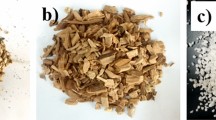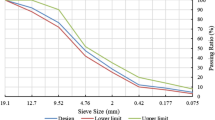Abstract
Due to the particularity of highway tunnel structure, traffic accidents are easy to cause severe fires on bituminous pavement. Fire leads to the thermal decomposition of bituminous pavement, resulting in very serious consequences. In this study, such flame retardants as expanded graphite, ferric hypophosphite, ammonium polyphosphate and zinc borate were mixed at a mixing ratio of 1:3:4 to prepare composite flame retardant (CFR). Flame-retarding warm mix agent (FWA) was developed by loading CFR on porous warm mix agent (WMA). The thermal decomposition properties of WMA, FWA and CFR were studied using differential scanning calorimetry/ thermogravimetry. Then, suppression effects of CFR and FWA on thermal decomposition and combustion kinetics of bitumen were investigated. Influences of CFR and FWA on morphology and composition of bituminous combustion residues were studied using field emission-scanning electron microscopy. Test results show that flame retardant constituents in CFR decompose in turn during the continuous temperature rise, which effectively inhibits whole process of bituminous thermal decomposition and combustion. WMA shows a collaborative promotion action on CFR, and effectively improves the dispersion of CFR in bitumen. Moreover, WMA promotes the formation of denser and thicker carbonized layers. FWA significantly inhibits thermal decomposition behaviors of bitumen and adsorbs many macromolecular volatiles.











Similar content being viewed by others
References
An W, Wang X, Tang Y, Wang T, Lu J (2021) Influence of cable inclination angle and longitudinal ventilation on temperature distribution during cable fire in utility tunnel. Case Stud Therm Eng 27:101304. https://doi.org/10.1016/j.csite.2021.101304
Shi C, Zhong M, Chen C, Jiao W, Li J, Zhang Y, Zhang L, Li Y, He L (2020) Metro train carriage combustion behaviors-full-scale experiment study. Tunn Undergr Space Technol 104:103544. https://doi.org/10.1016/j.tust.2020.103544
Yao Y, Wang R, Xia Z, Ren F, Zhao J, Zhu H, Cheng X (2022) Numerical study of the characteristics of smoke spread in tunnel fires during construction and method for improvement of smoke control. Case Studies Therm Eng 34:102043. https://doi.org/10.1016/j.csite.2022.102043
Yao Y, Li Y, Lönnermark A, Ingason H, Cheng X (2019) Study of tunnel fires during construction using a model scale tunnel. Tunn Undergr Sp Tech 89:50–67. https://doi.org/10.1016/j.tust.2019.03.017
Ren R, Zhou H, Hu Z, He S, Wang X (2019) Statistical analysis of fire accidents in Chinese highway tunnels 2000–2016. Tunn Undergr Sp Tech 83:452–460. https://doi.org/10.1016/j.tust.2018.10.008
Haurie L, Lacasta AM, Ciudad A, Realinho V, Velasco JI (2013) Addition of flame retardants in epoxy mortars: thermal and mechanical characterization. Constr Build Mater 42:266–270. https://doi.org/10.1016/j.conbuildmat.2012.12.012
Liang Y, Yu J, Feng Z, Ai P (2013) Flammability and thermal properties of bitumen with aluminium trihydroxide and expanded vermiculite. Constr Build Mater 48:1114–1119. https://doi.org/10.1016/j.conbuildmat.2013.07.074
Xu T, Huang X, Zhao Y (2011) Investigation into the properties of asphalt mixtures containing magnesium hydroxide flame retardant. Fire Safety J 46(6):330–334. https://doi.org/10.1016/j.firesaf.2011.05.001
Qin X, Zhu S, Chen S, Deng K (2013) The mechanism of flame and smoke retardancy of asphalt mortar containing composite flame retardant material. Constr Build Mater 41:852–856. https://doi.org/10.1016/j.conbuildmat.2012.12.048
Liu H, Zhang Z, Wang Z, Sun J, Wei Y, Zhang D (2023) Preparation and properties of flame-retardant asphalt containing polyurethane and eco-friendly flame retardants. Constr Build Mater 375:130996. https://doi.org/10.1016/j.con-buildmat.2023.130996
Zhao Y, Wang Y, Wang M, Liang N, Li Z (2023) Bio-mediated MOF-derived core–shell flame retardant: Towards styrene–butadiene–styrene asphalt with enhanced flame safety and pavement performance. Constr Build Mater 392:131408. https://doi.org/10.1016/j.conbuildmat.2023.131408
Buddhala A, Hossain Z, Wasiuddin NM, Zaman M, O’Rear EA (2012) Effects of an amine anti-stripping agent on moisture susceptibility of sasobit and aspha-min mixes by surface free energy analysis. J Test Eval 40:91–99. https://doi.org/10.1520/JTE103618
Almeida-Costa A, Benta A (2016) Economic and environmental impact study of warm mix asphalt compared to hot mix asphalt. J Clean Prod 112:2308–2317. https://doi.org/10.1016/j.jclepro.2015.10.077
Cheraghian G, Falchetto AC, You ZP, Chen SY, Kim YS, Westerhoff J, Moon KH, Wistuba MP (2020) Warm mix asphalt technology: an up to date review. J Clean Prod 268:122128. https://doi.org/10.1016/j.jclepro.2020.122128
Liu S, Peng A, Zhou S, Meng H (2019) Effect of foaming water on rheological and microscopic properties of foamed warm-mix asphalt binders. J Transport Eng, Part B: Pavements 145:04019019. https://doi.org/10.1061/JPEODX.0000118
Bennert T, Reinke G, Mogawer W, Mooney K (2010) Assessment of workability and compactability of warm-mix asphalt. Transp Res Rec J Transp Res Board 2180:36–47. https://doi.org/10.3141/2180-05
Zhang X, Zhu S, Zhu J, Lyu Q, Wei K, Huang Q, Li G, Xia H (2022) TG-MS study on co-combustion characteristics and coupling mechanism of coal gasification fly ash and coal gangue by ECSA®. Fuel 314:123086. https://doi.org/10.1016/j.fuel.2021.123086
Wu W, Zhang R, Wang Z, Li J, Cui X, Zhong L, Yan B, Chen G, Lu W (2022) Catalytic pyrolysis of biogas residues with incineration bottom ash by TG-MS: kinetics analysis and biochar stability. Fuel 322:124253. https://doi.org/10.1016/j.fuel.2022.124253
Ni Z, Bi H, Jiang C, Sun H, Zhou W, Qiu Z, Lin Q (2022) Research on the co-pyrolysis of coal slime and cellulose based on TG-FTIR-MS, artificial neural network, and principal component analysis. Fuel 320:123960. https://doi.org/10.1016/j.fuel.2022.123960
Bai H, Mao N, Wang R, Li Z, Zhu M, Wang Q (2021) Kinetic characteristics and reactive behaviors of HSW vitrinite coal pyrolysis: a comprehensive analysis based on TG-MS experiments, kinetics models and ReaxFF MD simulations. Energy Rep 7:1416–1435. https://doi.org/10.1016/j.egyr.2021.09.100
Baqain M, Neshumayev D, Konist A (2024) TG-MS analysis and kinetic study of co-combustion of ca-rich oil shale with biomass in air and oxy-like conditions. Carbon Capture Sci Technol 10:100162. https://doi.org/10.1016/j.ccst.2023.100162
Li RX, Zhang KW, Wu JH, Liu WJ (2019) Performance of warm-mixed flame retardant modified asphalt binder. Appl Sci 9:1491. https://doi.org/10.3390/app9071491
Tan LZ, Wang SW, Xu T, Xia WJ (2022) Inhibitory effects of composite fire retardant loaded in porous warm-mix agent on asphalt pyrolysis and volatile emission. J Mater Civ Eng 34:04022264. https://doi.org/10.1061/(ASCE)MT.1943-5533.0004402
Wang SW, Tan LZ, Xu T (2021) Compounding scheme optimization of composite flame retardant and its synergistic inhibitory effects on bituminous combustion. J Mater Civ Eng 34:04022146. https://doi.org/10.1061/(ASCE)17MT.1943-5533.0004300
Camino G, Costa L, Trossarelli L (1984) Study of the mechanism of intumescence in fire retardant polymers. Polym Degrad Stab 7:25–31. https://doi.org/10.1016/0141-3910(84)90027-2
Liu GS, Chen WY, Yu JG (2010) A novel process to prepare ammonium polyphosphate with crystalline form ii and its comparison with melamine polyphosphate. Ind Eng Chem Res 49:12148–12155. https://doi.org/10.1021/ie1014102
Schubert DM, Alam F, Visi MZ, Knobler CB (2003) Structural characterization and Chemistry of the industrially important zinc borate, Zn[B3O4(OH)3]. Chem Mater 15:866–871. https://doi.org/10.1021/cm020791z
Shi XX, Xiao Y, Li M, Yuan L, Sun J (2008) Synthesis of an industrially important zinc borate, 2ZnO·3B2O3·3H2O, by a rheological phase reaction method. Powder Technol 186:263–266. https://doi.org/10.1016/j.powtec.2007.12.014
Genovese A, Shanks RA (2007) Structural and thermal interpretation of the synergy and interactions between the fire retardants magnesium hydroxide and zinc borate. Polym Degrad Stab 92:2–13. https://doi.org/10.1016/j.polymdegradstab.2006.10.006
Samyn F, Bourbigot S, Duquesne S, Delobel R (2007) Effect of zinc borate on the thermal degradation of ammonium polyphosphate. Thermochim Acta 456:134–144. https://doi.org/10.1016/j.tca.2007.02.006
Khalili P, Liu XL, Tshai KY, Rudd C, Yi X, Kong I (2019) Development of fire retardancy of natural fiber composite encouraged by a synergy between zinc borate and ammonium polyphosphate. Compos Part B 159:165–172. https://doi.org/10.1016/j.compositesb.2018.09.036
Kök MV, Gul KG (2013) Combustion characteristics and kinetic analysis of Turkish crude oils and their SARA fractions by DSC. J Therm Anal Calorim 114:269–275. https://doi.org/10.1007/s10973-013-3256-3
Rishwana SS, Mahendran A, Vijayakumar CT (2015) Studies on structurally different benzoxazines based on diphenols and diamines: kinetics of thermal degradation and TG-FTIR studies. Thermochim Acta 618:74–87. https://doi.org/10.1016/j.tca.2015.09.006
Shi HQ, Xu T, Zhou P, Jiang R (2017) Combustion properties of saturates, aromatics, resins, and asphaltenes in asphalt binder. Constr Build Mater 136:515–523. https://doi.org/10.1016/j.conbuildmat.2017.01.064
Pei JZ, Wen Y, Li YW, Shi X, Zhang J, Li R, Du Q (2014) Flame-retarding effects and combustion properties of asphalt binder blended with organo montmorillonite and alumina trihydrate. Constr Build Mater 72:41–47. https://doi.org/10.1016/j.conbuildmat.2014.09.013
Acknowledgements
Authors would like to thank the financial support from National Natural Science Foundation of China (No. 51978340, 52208440), Natural Science Foundation of Jiangsu Province (BK20210618), Natural Science Foundation of the Jiangsu Higher Education Institutions of China (21KJB580003), and the open research fund of Highway Engineering Key Laboratory of Sichuan Province, Southwest Jiaotong University (HEKLSP2022-09).
Author information
Authors and Affiliations
Corresponding authors
Additional information
Publisher's Note
Springer Nature remains neutral with regard to jurisdictional claims in published maps and institutional affiliations.
Rights and permissions
Springer Nature or its licensor (e.g. a society or other partner) holds exclusive rights to this article under a publishing agreement with the author(s) or other rightsholder(s); author self-archiving of the accepted manuscript version of this article is solely governed by the terms of such publishing agreement and applicable law.
About this article
Cite this article
Xia, W., Teng, W. & Xu, T. Development and properties of porous warm mix agent-loaded composite flame retardant and its suppressions on bituminous combustion and volatile release. Mater Struct 57, 27 (2024). https://doi.org/10.1617/s11527-024-02299-w
Received:
Accepted:
Published:
DOI: https://doi.org/10.1617/s11527-024-02299-w




